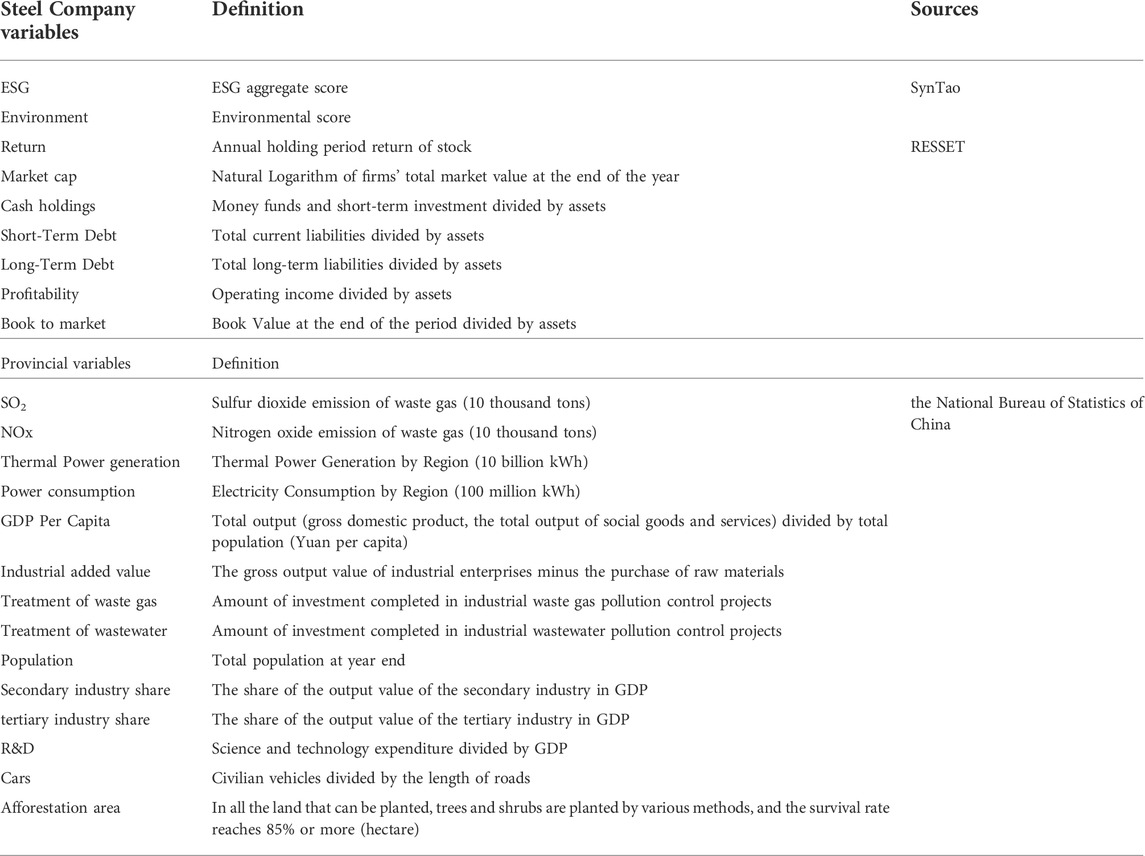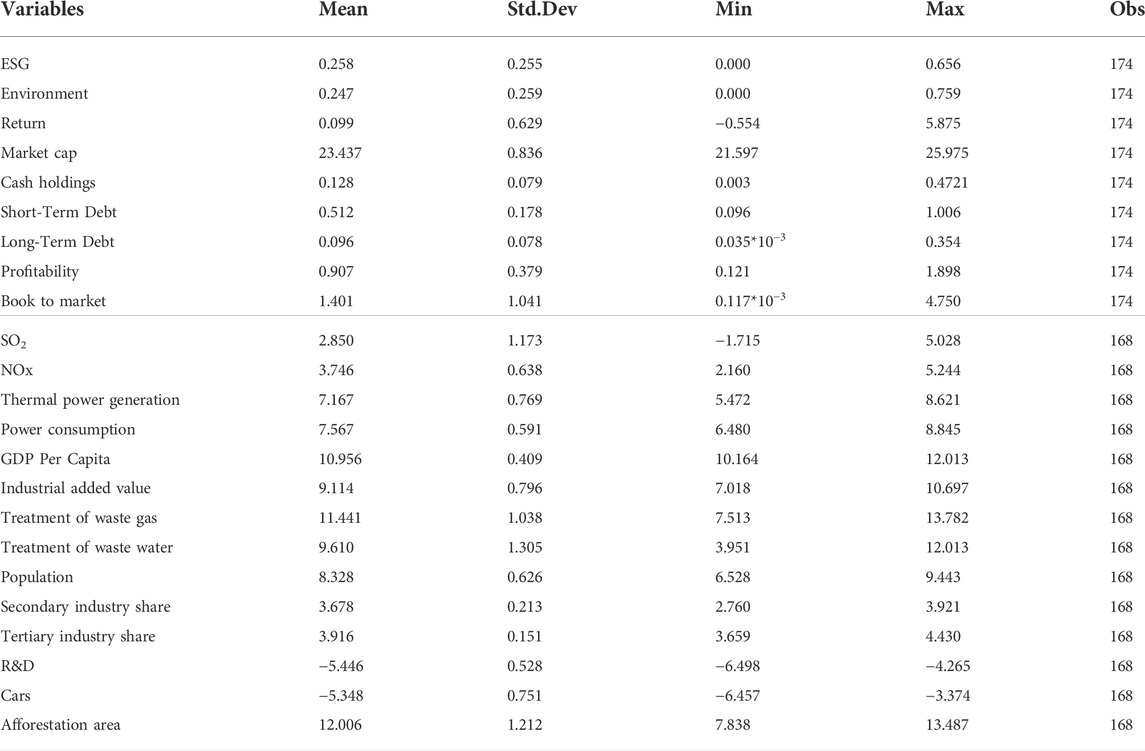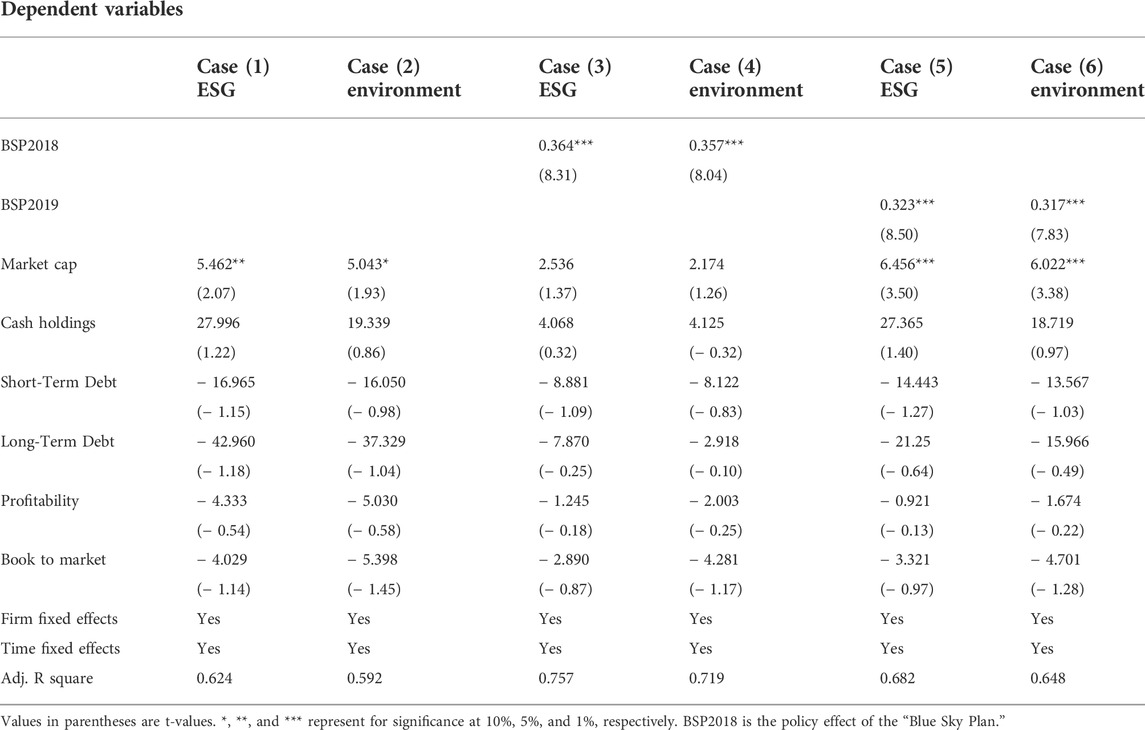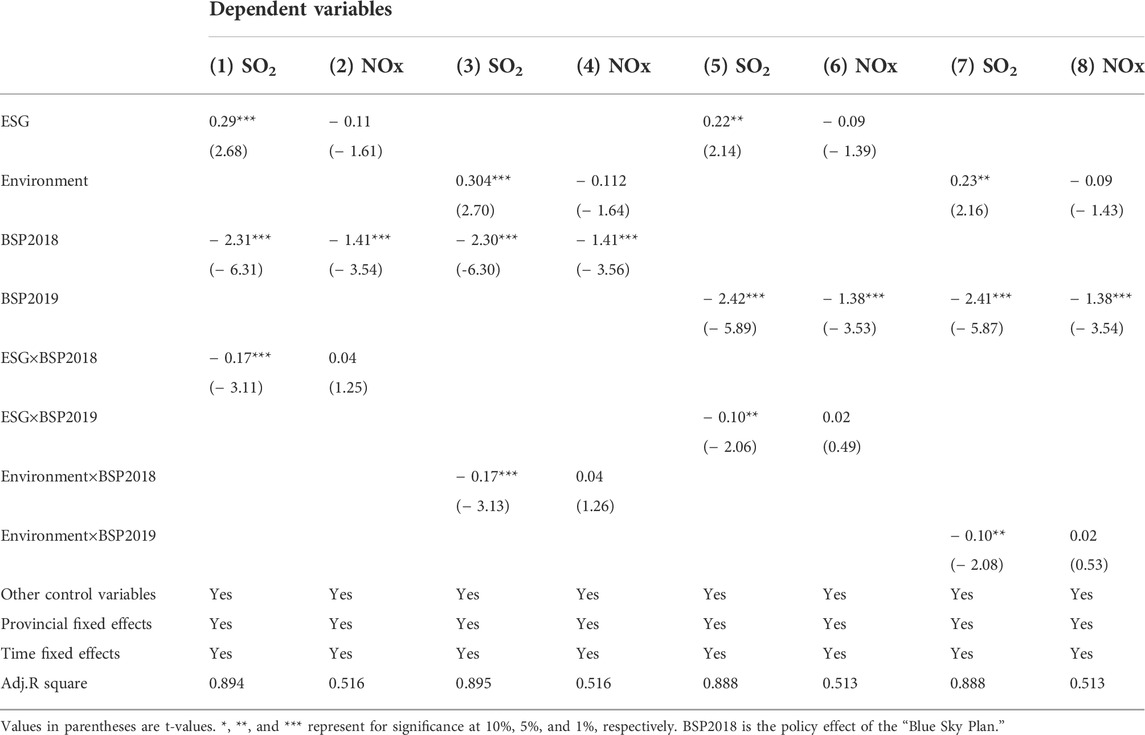- 1Graduate School of Economics, Kobe University, Kobe, Japan
- 2Research Center of Finance, Shanghai Business School, Shanghai, China
This study aims to examine the policy effects of the “Three-Year Action Plan to Win the Blue Sky War” on the steel industry and air pollution in China. Specifically, we analyze the impact of the “Blue Sky Plan” on Chinese steel companies’ ESG investments, corporate financial performance, and the emissions of sulfur dioxide and nitrogen oxides in the exhaust gas. Our evidence suggests that ESG investment in steel companies can lead to a significant decrease in financial performance. The “Blue Sky Plan” compensated for about one-third of corporate ESG investment losses and played a significant role in promoting the ESG investment of steel companies. In addition, we found that after the implementation of the “Blue Sky Plan,” the emissions of sulfur dioxide and nitrogen oxides in the exhaust gases were significantly reduced.
1 Introduction
Environmental pollution is widely recognized as an important issue for sustainable economic growth. In recent years, with rapid economic development, China has been consuming a large amount of fossil energy. Air pollution in China has reached a serious level, causing environmental and health problems (Chen et al., 2017), and has largely aroused residents’ dissatisfaction. Since then, the Chinese government has attached great importance to the ecological environment and has made many efforts to achieve specific emission reduction targets in the “13th Five-Year Plan” (2016–2020) to tackle environmental deterioration. These reduction targets mainly focus on the emission of nitrogen oxides and sulfur dioxide. In 2018, the Chinese government issued a “Three-Year Action Plan to Win the Blue Sky war” (hereinafter the “Blue Sky Plan”). In 2015, China’s total SO2 and NOx emissions were 18.591 million tons and 18.518 million tons, respectively. The major goal of the “Blue Sky Plan” is to reduce the total emissions of sulfur dioxide and nitrogen oxides by more than 15% by 2020.
Environmental pollution can be classified into water and air pollution. In terms of water pollution, Chen et al. (2018) studied the water pollution regulation in China and found evidence that the regulation reduced pollution-intensive activities in highly regulated areas. Liu et al. (2017) estimated the impact of stricter wastewater discharge standards on all the textile printing and dyeing enterprises in Lake Tai. They find that enterprises facing new, more stringent standards decrease labor demand by approximately 7%. Most countries have begun to monitor air quality in recent years. Peng et al. (2019) examined the consistency of city- and individual-level air pollution perceptions and investigated how environmental transparency affects the actual perceived air pollution relationship. Ai et al. (2021) studied the relationship between the desulfurization price subsidy policy and SO2 emission reduction from coal-fired power plants in China. They found an obvious causal relationship between the policy and SO2 emission reduction, and the dynamic effect of the policy showed an upward trend throughout the sample period. In terms of studying policy effects, Lin et al. (2021) examined the impact of the Electricity Price Subsidy policy on NOX emission from China’s coal-fired power generation industry. They found that the EPS policy significantly reduced NOX emissions by 1.1% and increased NOX removal by 2.8%.
This study focuses on the policy effects of the “Blue Sky Plan” on the steel industry as well as the emissions of sulfur dioxide and nitrogen oxides. Although the problem of environmental pollution has been raised for decades, the Chinese government has been balancing economic growth and environment problems until the serious air pollution occurred. Air pollution became the most serious environmental problem in China since 2013, which not only significantly harmed the public health, but also decreased satisfactory to the government. The implementation of “Blue Sky Plan” is the first time the Chinese government decided to protect the environment at the cost of sacrificing economic growth. In 2017, the major pollutant emissions from the steel industry exceeded those of the power industry and became the largest source of pollutant emissions in the industrial sector. The steel industry in China has become a major source of air pollutants such as particulate matter, SO2, and NOx emissions. For the purpose of investigating the policy effect of the “Blue Sky Plan” on air pollution, we focus on the steel industry instead of the whole polluting industries, to avoid using irrelevant information (e.g. water pollution).
Gu et al. (2018) analyzed the sulfur dioxide emission reduction effect, energy-saving synergy effect, and carbon dioxide emission reduction of power generation, steel, and cement industries during the “11th Five-Year Plan” and “12th Five-Year Plan” periods. They showed that during the “11th Five-Year” period, the emission reduction of coal-fired power plants’ desulfurization projects is critical to emission reduction. Both engineering and structural reductions can achieve low pollution emissions, but the contributions are not the same, owing to differences in related industries. Bo et al. (2021) used measurements from China’s continuous emissions monitoring system to develop estimates of emissions from the steel industry. They assessed particulate matter, sulfur dioxide, and nitrogen oxide emissions associated with China’s increasingly stringent policies from 2014 to 2018.
Recently, ESG investment has attracted substantial research attention (see Zhao et al., 2018; Gillan et al., 2021). Yuan et al. (2022) investigated the impact of ESG disclosure on the financial irregularities of Chinese listed firms. They find that ESG disclosures decrease corporate financial irregularity risks and help mitigate information asymmetry. Zhang et al. (2021) examined the heterogeneity of ESG investments in China before and after the release of the guidelines for establishing a green financial system in 2016. They show that high-ESG portfolios earn significantly higher abnormal returns than low-ESG portfolios after 2016.
Existing research rarely investigates policy effects on ESG investments in the steel industry. To the best of our knowledge, this is the first study to investigate the policy effects of the “Blue Sky Plan” on the steel industry in China. We close this gap and contribute to the literature in the following ways. First, we collected the latest available environmental, industrial, and financial data and analyzed the policy effect of the “Blue Sky Plan” on ESG investment and financial performance in China’s steel industry. Second, we collected provincial economic and environmental data to investigate the policy effects on air pollution.
Our results suggest that ESG investment significantly reduces the financial performance of steel companies, contrary to the findings of Zhang et al. (2021). The “Blue Sky Plan” compensates for one-third of losses from corporate ESG investments and significantly stimulates ESG investment in the steel industry. In addition, we find that the “Blue Sky Plan” reduces SO2 and NOx emissions significantly and alleviates China’s air pollution problem to a large extent.
The remainder of this paper is organized as follows. Section 2 briefly describes the study’s data. Section 3 introduces the model. The empirical results are presented in Section 4. Section 5 concludes the paper.
2 Data
The sample period for our data is from 2015 to 2020. We collected the latest and most complete relevant environmental and financial data for Chinese listed steel companies. Specifically, the ESG data come from China’s SynTao Green Finance, including ESG investment and environmental scores. The financial data of the steel companies were sourced from the RESSET database, including a range of financial variables such as stock return, market cap, cash holdings, short-term debt, long-term debt, profitability, and book-to-market ratio. Provincial economic and environmental data for 28 provinces were collected from the National Bureau of Statistics of China, including SO2 emissions, NOx emissions, thermal power generation, power consumption, GDP per capita, industrial added value, treatment of waste gas, treatment of wastewater, population, secondary industry share, tertiary industry share, R&D, cars, and the affected area. Table 1 briefly describes the definitions of the variables. Table 2 provides descriptive statistics of the data.
3 Models
First, we construct a heterogeneous timing difference-in-differences (HT-DID) model to examine the policy effect of the “Blue Sky Plan” on the relationship between ESG investment and the financial performance of steel companies. The model is represented as follows:
where
Similarly, we construct the following HT-DID model to investigate the policy effect of the “Blue Sky Plan” on steel companies’ ESG investment decisions.
Finally, we studied the effect of the policy on air pollution. Specifically, we collected provincial economic and environmental data and investigated whether SO2 and NOx emissions were reduced significantly after the “Blue Sky Plan.” The model is introduced as follows.
where
4 Empirical results
In this section, we first study whether steel companies’ ESG investment affects their financial performance and explore the impact of the “Blue Sky Plan” on the relationship between corporate ESG investment and profitability. We then examine the policy effect of the “Blue Sky Plan” on steel companies’ ESG investment decisions; finally, we examine whether the “Blue Sky Plan” reduces air pollutant emissions.
Table 3 reports the empirical results of Eq. 1. For comparison, we also provide conventional panel regression analysis. Case (1) shows that the ESG investment of steel companies will significantly reduce their financial performance. A 1% increase in the company’s ESG investment will reduce the stock return by 0.378%, indicating that the ESG investment of steel companies will not bring immediate benefits. On the contrary, the cost of R&D investment related to emission reduction and fixed asset investment will cause significant losses to the enterprise.
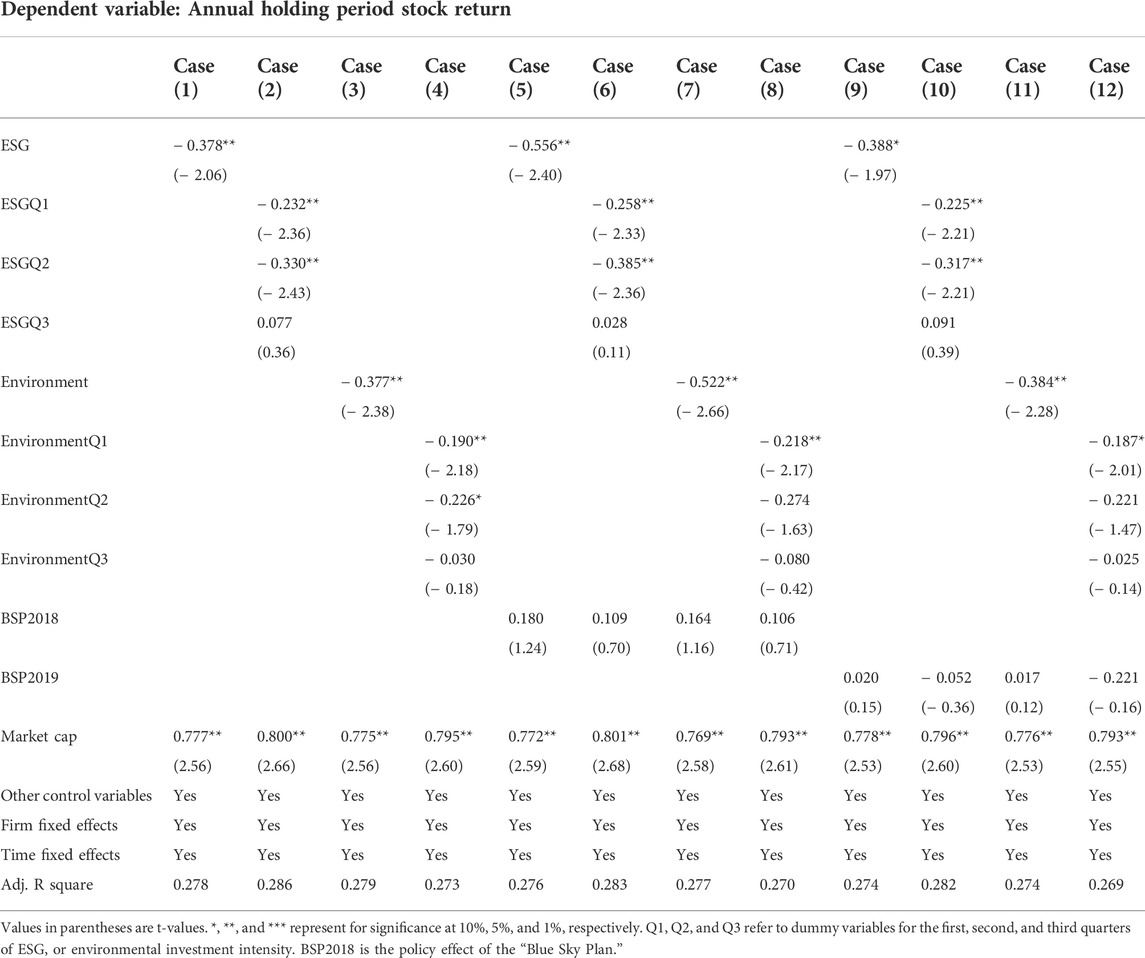
TABLE 3. Policy effects of the “Blue Sky Plan” on the financial performance of China’s steel industry.
Then, following Lins et al. (2017), we quartile the ESG scores before introducing them into the model. Specifically, we divide the annual ESG investment status of steel companies into four equal parts, from high to low. Case (2) shows that the top 50% of companies in the steel industry for ESG investment suffer significant losses in their financial performance. However, the marginal ESG investment loss for Q1 companies is 0.232%, which is much smaller than that for Q2 companies, suggesting that companies with the most ESG investments may already be reaping the benefits.
We then replaced the ESG scores with environmental scores and arrived at similar conclusions. Case (3) shows that a firm’s environmental investment, such as ESG investment, significantly reduces stock returns. The coefficients of the parameters are very similar to those in Case (1), which indicates that the ESG investments of these steel companies are mainly environmental investments rather than social and corporate governance investments.
Similarly, Case (4) shows that the top 50% of companies with environmental investment suffer significant financial losses. Q1 companies suffer less than Q2 companies, suggesting that the companies with the largest environmental investments may have already gained from them.
Cases (5–8) perform a heterogeneous timing difference-in-differences analysis to study the policy effect of the “Blue Sky Plan.” Case (5) suggests that a 1% increase in ESG investment will reduce the stock return by 0.556%, indicating that the coefficient of
Case (6) showed similar results. The marginal losses from ESG investments are much larger than those in Case (2). This is consistent with the results obtained in case (5). However, we also find that Q1 companies suffer fewer financial losses than Q2 companies, suggesting that the ESG investment has already yielded.
From case (7), it can be seen that each 1% increase in environmental investment reduces the stock return by 0.552%. First, this indicates that the coefficient of the variable Environmental in case (3)
Overall, from the comparison of cases (5–8), (1–4), we find that the “Blue Sky Plan” cannot significantly change the status quo of the decline in corporate financial performance caused by the ESG investment of steel companies. Corporate ESG investments cause significant declines in stock returns. After the implementation of the “Blue Sky Plan,” companies that invested heavily in ESG achieved certain benefits through subsidies, emission taxes, and emissions allowance trading. Therefore, we conclude that the “Blue Sky Plan” may play a role in promoting corporate ESG investment and green transformation.
One may suspect that there should be a time-lag between the implementation of the policy and its impact occurred. Since the time-lag of policy effect may lead to endogeneity, we delay the effect of the “Blue Sky Plan” to 2019, and report these results in case (9–12). Similarly, ESG investment significantly reduce the stock returns of steel companies. However, these estimates are much closer to case (1–4) than case (5–8), suggesting that the impact of the “Blue Sky Plan” has been quickly absorbed, and the steel industry rebalanced production and environmental protection in a short time.
We then investigate whether the “Blue Sky Plan” stimulates ESG investments. Table 4 presents the results of Eq. 2. Case (1) shows that the larger the market cap of a company, the more ESG investments it has made, indicating that large steel companies are more willing to make ESG investments. On the one hand, large enterprises have sufficient capital to invest in fixed assets and R&D. On the other hand, large enterprises are more likely to obtain emission reduction subsidies and tax relief and are more likely to benefit from emissions trading. In case (2), we substituted environmental scores for ESG scores and obtained similar results to case (1).
Case (3) shows that the “Blue Sky Plan” significantly affects enterprises’ ESG investment. After the introduction of policy effects, the coefficient of the market cap no longer becomes significant, indicating that after the implementation of the policy, companies started to make ESG investments regardless of their size. Combining case (1), we can argue that the policy played a significant role in promoting ESG investment in small firms. Similar to Case (3), Case (4) shows that the policy has a significant effect on stimulating the environmental investment of enterprises. In general, the “Blue Sky Plan” has a significant positive impact on ESG and environmental investment, especially for relatively small-scale enterprises. In case (5, 6), the impact of the policy is supposed to be delayed. Obviously, the “Blue Sky Plan” still has significantly impact on corporate ESG investment.
Finally, we examined whether the “Blue Sky Plan” could reduce air pollutant emissions. Table 5 presents the results of Eq. 3. Case (1) shows that ESG investment positively related to SO2 emission, since both of them are positively correlated with industrial level. However, the estimates of the “Blue Sky Plan” and its product with ESG investment are significantly negative, indicating that the implementation of the “Blue Sky Plan” has a significant inhibitory effect on SO2 emissions. Similarly, case (2) shows that the “Blue Sky Plan” also significantly reduced NOx emissions. We replace ESG by environmental investment in case (3, 4), and obtain similar results. In case (5–8), the policy effect of the “Blue Sky Plan” is supposed to be delayed. Similarly, we still find that SO2 and NOx emissions are significantly reduced after the implementation of the “Blue Sky Plan”. Overall, our results suggest that the “Blue Sky Plan” has significantly alleviated China’s air pollution problems and gradually achieved the policy goals.
5 Conclusion
With the rapid development of China’s economy, environmental pollution, especially air pollution, has seriously affected the quality of life of Chinese residents, arousing government concern. As the world’s largest producer and exporter of crude steel, the pollution generated by China’s steel industry has surpassed that of the power industry, ranking first among China’s highly polluting industries. In this context, the Chinese government launched the Three-Year Action Plan to Win the “Blue Sky War,” which aims to solve problems such as promoting the green transformation of high-polluting industries and curbing air pollution. This study is the first to examine the policy effects of the “Blue Sky Plan” on China’s steel industry. We first analyze the impact of the “Blue Sky Plan” on steel companies’ ESG investment and financial performance. We then examine the effects of the “Blue Sky Plan” on air pollution.
From the perspective of the ESG investment of steel enterprises, the ESG-related investment of listed steel enterprises has a significant negative impact on their financial performance, especially for those companies that heavily invest in ESG. This is because these investments cost a large amount of capital in R&D and fixed assets. The “Blue Sky Plan” has compensated for the ESG investment losses of steel companies to a certain extent, with an average rate of about one-third. Additionally, we found that the “Blue Sky Plan” significantly stimulated steel companies’ ESG investments. Finally, the “Blue Sky Plan” has significantly reduced emissions of sulfur dioxide and nitrogen oxides, which has played a positive role in improving air pollution problems.
Data availability statement
The datasets presented in this study can be found in online repositories. The names of the repository/repositories and accession number(s) can be found in the article/Supplementary Material.
Author contributions
PL conducted the empirical analysis and wrote the paper. Conceptual design is performed by PL, SH, and ST.
Funding
This work was supported by JSPS KAKENHI (grant number 22K01424).
Conflict of interest
The authors declare that the research was conducted in the absence of any commercial or financial relationships that could be construed as a potential conflict of interest.
Publisher’s note
All claims expressed in this article are solely those of the authors and do not necessarily represent those of their affiliated organizations, or those of the publisher, the editors and the reviewers. Any product that may be evaluated in this article, or claim that may be made by its manufacturer, is not guaranteed or endorsed by the publisher.
Supplementary material
The Supplementary Material for this article can be found online at: https://www.frontiersin.org/articles/10.3389/fenvs.2022.955906/full#supplementary-material
References
Ai, H., Zhou, Z., Li, K., and Kang, Z. Y. (2021). Impacts of the desulfurization price subsidy policy on SO2 reduction: Evidence from China’s coal-fired power plants. Energy Policy 157, 112477. doi:10.1016/j.enpol.2021.112477
Bo, X., Jia, M., Xue, X., Tang, L., Mi, Z., Wang, S., et al. (2021). Effect of strengthened standards on Chinese ironmaking and steelmaking emissions. Nat. Sustain. 4, 811–820. doi:10.1038/s41893-021-00736-0
Chen, R., Yin, P., Meng, X., Liu, C., Wang, L., Xu, X., et al. (2017). Fine particulate air pollution and daily mortality. A nationwide analysis in 272 Chinese cities. Am. J. Respir. Crit. Care Med. 196, 73–81. doi:10.1164/rccm.201609-1862OC
Chen, Z., Kahn, M. E., Liu, Y., and Wang, Z. (2018). The consequences of spatially differentiated water pollution regulation in China. J. Environ. Econ. Manage. 88, 468–485. doi:10.1016/j.jeem.2018.01.010
Drempetic, S., Klein, C., and Zwergel, B. (2020). The influence of firm size on the ESG score: Corporate sustainability ratings under review. J. Bus. Ethics 167, 333–360. doi:10.1007/s10551-019-04164-1
Gillan, S. L., Koch, A., and Starks, L. T. (2021). Firms and social responsibility: A review of ESG and csr research in corporate finance. J. Corp. Finance 66, 101889. doi:10.1016/j.jcorpfin.2021.101889
Gu, A., Teng, F., and Feng, X. (2018). Effects of pollution control measures on carbon emission reduction in China: Evidence from the 11th and 12th five-year Plans. Clim. Policy 18, 198–209. doi:10.1080/14693062.2016.1258629
Lin, C., Shao, S., Sun, W., and Yin, H. (2021). Can the electricity price subsidy policy curb NOX emissions from China’s coal-fired power industry? A difference-in-differences approach. J. Environ. Manage. 290, 112367. doi:10.1016/j.jenvman.2021.112367
Lins, K. V., Servaes, H., and Tamayo, A. (2017). Social capital, trust, and firm performance: The value of corporate social responsibility during the financial crisis. J. Finance 72, 1785–1824. doi:10.1111/jofi.12505
Liu, M., Shadbegian, R., and Zhang, B. (2017). Does environmental regulation affect labor demand in China? Evidence from the textile printing and dyeing industry. J. Environ. Econ. Manage. 86, 277–294. doi:10.1016/j.jeem.2017.05.008
Peng, M., Zhang, H., Evans, R. D., Zhong, X., and Yang, K. (2019). Actual air pollution, environmental transparency, and the perception of air pollution in China. J. Environ. Dev. 28, 78–105. doi:10.1177/1070496518821713
Yang, C., Wang, Y., and Dong, Z. (2020). Evaluating the impact of denitrification tariff on energy-related NOx generation in China: Policy effects and regional disparities. Energy Policy 142, 111520. doi:10.1016/j.enpol.2020.111520
Yuan, X., Li, Z., Xu, J., and Shang, L. (2022). ESG disclosure and corporate financial irregularities – evidence from Chinese listed firms. J. Clean. Prod. 332, 129992. doi:10.1016/j.jclepro.2021.129992
Zhang, W. W., Sharp, B., and Xu, S. C. (2019). Does economic growth and energy consumption drive environmental degradation in China’s 31 provinces? New evidence from a spatial econometric perspective. Appl. Econ. 51, 4658–4671. doi:10.1080/00036846.2019.1593943
Zhang, X., Zhao, X., and Qu, L. (2021). Do green policies catalyze green investment? Evidence from ESG investing developments in China. Econ. Lett. 207, 110028. doi:10.1016/j.econlet.2021.110028
Keywords: steel industry, policy effects, Blue Sky Plan, ESG investment, air pollution
Citation: Lu P, Hamori S and Tian S (2022) Policy effect of the “blue sky plan” on air pollution, ESG investment, and financial performance of china’s steel industry. Front. Environ. Sci. 10:955906. doi: 10.3389/fenvs.2022.955906
Received: 29 May 2022; Accepted: 25 July 2022;
Published: 25 August 2022.
Edited by:
Zhen Wang, Huazhong Agricultural University, ChinaCopyright © 2022 Lu, Hamori and Tian. This is an open-access article distributed under the terms of the Creative Commons Attribution License (CC BY). The use, distribution or reproduction in other forums is permitted, provided the original author(s) and the copyright owner(s) are credited and that the original publication in this journal is cited, in accordance with accepted academic practice. No use, distribution or reproduction is permitted which does not comply with these terms.
*Correspondence: Shuairu Tian, dGlhbnNyQHNicy5lZHUuY24=
 Peiyao Lu
Peiyao Lu Shigeyuki Hamori
Shigeyuki Hamori Shuairu Tian
Shuairu Tian